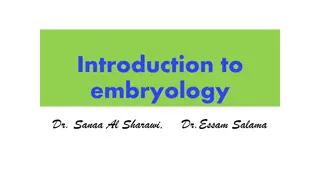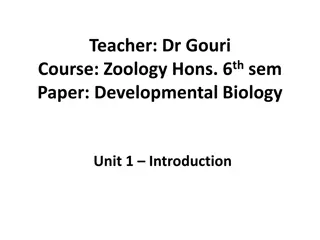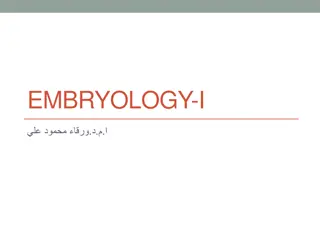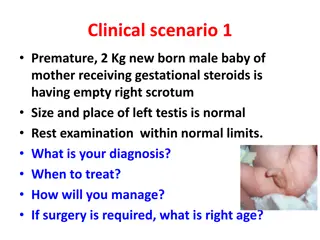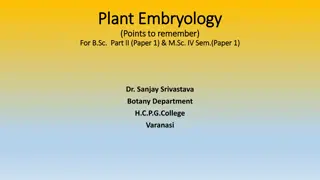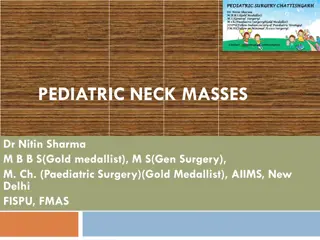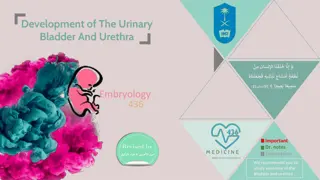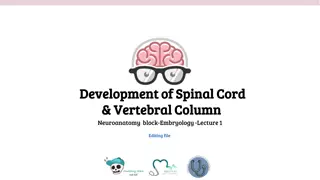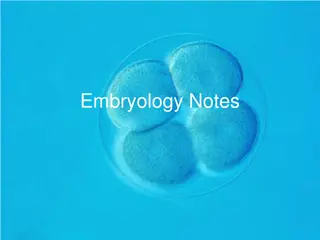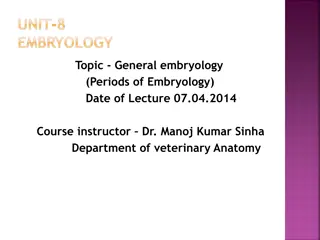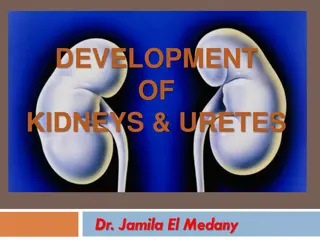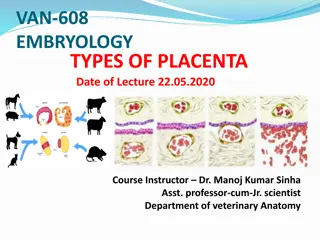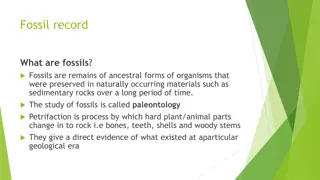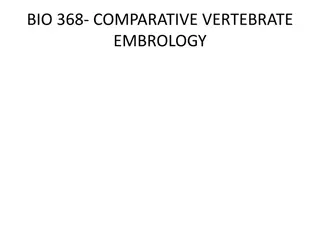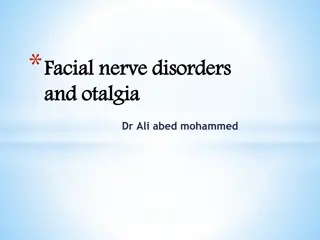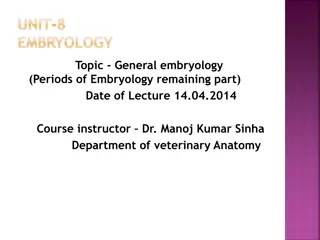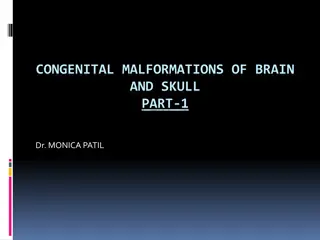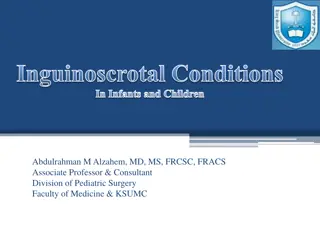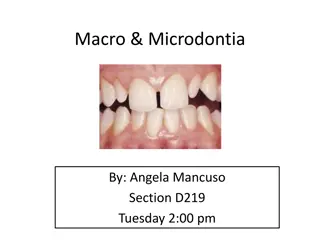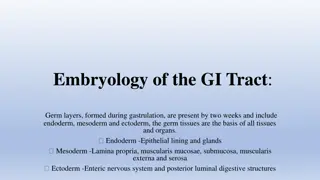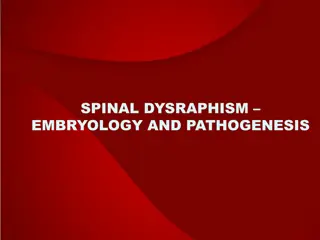Comprehensive Overview of Maxillary Sinus Anatomy and Function
The maxillary sinus, also known as the antrum of Highmore, is a key structure in the paranasal air sinuses. Described first in 1651, it plays a vital role in skull lightening, voice resonance, and air filtration. This pyramidal-shaped sinus is lined with Schneiderian membrane and has complex vascula
1 views • 41 slides
Anatomy of Intestine in Domestic Animals
The intestine in domestic animals plays a vital role in digestion and absorption. It consists of the small intestine for chemical digestion and absorption and the large intestine for water absorption and excretion. This article covers the gross anatomy, histology, and embryology of the intestine, de
2 views • 84 slides
Understanding Embryology: From Conception to Critical Periods
Embark on a journey through the fascinating world of embryology with Dr. Sanaa Al Sharawi and Dr. Essam Salama. Delve into the definition, significance, and developmental periods of embryology, learning about prenatal and postnatal stages, common terminologies like oocyte and zygote, and critical pe
1 views • 22 slides
Exploring the Historical Foundations of Developmental Biology
Delve into the historical background of developmental biology starting from ancient Greek scholars like Hippocrates and Aristotle to key figures like William Harvey and their contributions to the field. Learn about the evolution of theories such as epigenesis and preformation, shaping the study of e
0 views • 11 slides
Development of Human Face and Oral Cavity in Embryology
The process of embryonic development involves the formation of the human face and oral cavity from the morula stage onwards. Key structures such as the primitive streak play a vital role in establishing bilateral symmetry, initiating germ layer formation, and guiding gastrulation. The differentiatio
2 views • 32 slides
Undescended Testes: Clinical Scenarios, Diagnosis, and Management
Premature newborn with an empty right scrotum and a 30-year-old male presenting with an intra-abdominal lump and an empty right scrotum raise concerns of undescended testes, necessitating proper diagnosis and management. Understanding the embryology, clinical presentations, treatment options, and po
0 views • 36 slides
Insights into Plant Embryology: Points to Remember for Botany Students
Explore key points in plant embryology including terminology, structure of anthers, pollen grain formation, pollen viability testing, and aspects of meiosis. Understand the significant contributions of Prof. Panchanan Maheshwari to Indian plant embryology.
0 views • 11 slides
Surrogacy Laws in England: A Comprehensive Overview
England has been at the forefront of surrogacy legislation, with the Surrogacy Arrangements Act of 1985 and the Human Fertilisation and Embryology Act of 2008 establishing frameworks for surrogacy. Commercial surrogacy is scrutinized to ensure the welfare of the child is prioritized. The laws requir
0 views • 8 slides
Pediatric Neck Masses: Causes and Anatomy Explained by Dr. Nitin Sharma
Learn about pediatric neck masses, their causes including congenital, inflammatory, and malignant factors, and the embryology and anatomy behind them. Detailed insights are provided on the branchial system, its arches, pouches, and the structures they contribute to in the neck. Dr. Nitin Sharma, a h
0 views • 42 slides
Exploring the Fascinating World of Biology and Human Biology
Biology is a broad scientific field encompassing the study of living organisms and their various aspects, from anatomy and physiology to genetics and evolution. Branches of biology include anatomy, histology, cytology, physiology, embryology, genetics, molecular biology, biochemistry, zoology, botan
0 views • 21 slides
Development of the Urinary Bladder and Urethra in Embryology
Understanding the embryonic development of the urinary bladder and urethra involves studying the formation of the cloaca, division of the urogenital sinus, absorption of mesonephric ducts, position and fate of the urachus, and anomalies related to these structures. The cloaca, primitive urogenital s
0 views • 14 slides
Explore the World of Developmental and Cell Biology
Developmental biology, stemming from embryology, investigates how organisms evolve from a zygote. It merges various fields like genetics, cell biology, and cancer biology. Cell biology focuses on cell properties and behaviors, using tools like genomics and microscopy. Research areas include cancer c
0 views • 8 slides
Embryology of Spinal Cord and Vertebral Column Development
Explore the fascinating embryological journey of the spinal cord and vertebral column development, covering topics such as neural tube formation, layers of the spinal cord, subdivisions of mantle and marginal zones, chondrification, ossification stages, spina bifida types, and more. Dive into the st
1 views • 15 slides
Embryology Notes: Development from Fertilization to Gastrulation
Embryology is the study of the development of multicellular animals starting from fertilization when the sperm fertilizes the egg and forms the zygote. This initiates a series of events such as cleavage, morula formation, blastula development, and gastrulation, where three embryonic tissue layers ar
0 views • 24 slides
Embryology: Stages of Development and Gestation Period in Different Animals
Embryology covers the Germinal, Embryonic, and Fetal stages of development in animals, highlighting processes like cleavage and formation of morula. Additionally, it provides insights into the gestation periods of various animals ranging from cows and mares to humans and elephants, each with its uni
0 views • 16 slides
Development of Kidneys and Ureters in Embryology by Dr. Jamila El Medany
This educational material discusses the embryological origin and development of kidneys and ureters. It covers the three systems of kidney development, including the pronephric, mesonephric, and metanephric systems. Detailed descriptions of the formation of the permanent kidney (metanephros), the co
0 views • 17 slides
Types of Placenta in Embryology: Classification and Structure
The lecture discusses the classification of placenta based on the mode of attachment and distribution of chorionic villi. It covers folded, villous, and labyrinthine placenta along with diffuse, cotyledonary, zonary, and discoidal placenta types in different species. The structure of placenta involv
0 views • 16 slides
Understanding Evolutionary Evidence in Biology
Fossil records, comparative embryology, anatomy, convergent and divergent evolution, cell biology, and serology provide compelling evidence for common ancestry and evolutionary relationships among organisms. Fossils offer a glimpse into the past, while comparative studies highlight similarities in s
0 views • 7 slides
Understanding Vertebrate Embryology Through Evolutionary Development
Explore the fascinating world of comparative vertebrate embryology, examining how the development of an individual reflects its evolutionary journey. Delve into the principle of Ontogeny Recapitulates Phylogeny, common developmental plans, and the historic contributions of renowned embryologists lik
0 views • 17 slides
Understanding Facial Nerve Disorders: An Overview
Facial nerve disorders can lead to various symptoms such as facial paralysis and otalgia. This article covers the embryology, anatomy, and neuropathophysiology of the facial nerve. The development of the facial nerve complex occurs in the early stages of gestation, and abnormalities may be associate
0 views • 39 slides
Understanding General Embryology: Germinal Layers and Organ Formation
General embryology covers the development of organs and tissues from the three germinal layers - ectoderm, mesoderm, and endoderm. Ectoderm gives rise to the nervous system and body covering, mesoderm forms skeletal tissue and muscles, while endoderm forms the gut lining. Derivatives of each layer i
0 views • 10 slides
Understanding Congenital Malformations of Brain and Skull Part 1: Embryology and Neurulation
This educational material explores the embryological development of brain and skull structures, focusing on neurulation processes, formation of brain vesicles, and potential errors leading to malformations. From neurulation initiation to neuronal proliferation and migration, the content delves into
0 views • 62 slides
Inguinoscrotal Conditions in Infants and Children - Overview
This informative article discusses inguinoscrotal conditions in infants and children, including inguinal hernia, hydrocele, undescended testis, and acute scrotum. It covers the pathology, embryology, anatomy, prevalence, associated conditions, history, and examination related to these conditions. Th
0 views • 28 slides
Comprehensive Overview of Respiratory Block for Medical Students
This respiratory block introduces students to the anatomy, histology, muscles involved in respiration, embryology, radiological anatomy, and management of respiratory disorders. It covers topics like the nasal cavity, pharynx, larynx, trachea, bronchi, lungs, pleura, bronchial tree, and mediastinum.
0 views • 23 slides
Understanding Macro and Microdontia in Dentistry
Macro and microdontia refer to abnormally large and small teeth, respectively. They can be associated with hormonal imbalances like hypopituitarism and hyperpituitarism. In some cases, certain population groups may have naturally larger teeth due to heredity. Dental hygienists play a key role in ide
0 views • 7 slides
Embryology of the GI Tract and Development of the Gut Tube
Embryology of the gastrointestinal (GI) tract involves the formation of germ layers during gastrulation, leading to the development of endoderm, mesoderm, and ectoderm. By incorporating the yolk sac, the primitive gut tube emerges during weeks 3-4 and is divided into foregut, midgut, and hindgut, gi
1 views • 25 slides
Embryology and Pathogenesis of Spinal Dysraphism
Gastrulation, the formation of germ layers, mesoderm, and endoderm, in the embryo occurs during the third week of gestation with the appearance of the primitive streak. Cells migrate to form endoderm and mesoderm while the ectoderm remains. Neural induction is regulated by factors like fibroblast gr
0 views • 49 slides


